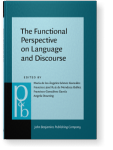A lexico-paradigmatic approach to English setting-constructions
In this paper I will explore the relationship between constructional and verbal
semantics in a two-participant construction exemplified by expressions like I
broke my arm (when I fell) (Talmy 2000, 518), where the Subject is described as
a mere circumstantial setting for the process (Davidse 1992, 128). Drawing on
corpus data with change-of-state verbs, I will illustrate the syntactic contexts
where this construction occurs in English, analysing how the particular uses
of these verbs interact with the semantico-pragmatic value of the construction.
Along the lines of Lemmens (2006), and building on previous work of mine
(Guerrero Medina 2010), I will adopt a lexico-paradigmatic view and argue
that the paradigmatic behaviour of a verb is actually determined by the entire
construction.
References (27)
References
Berry, Margaret. 1975.
An Introduction to Systemic Linguistics. 1 Structures and Systems
. London: B. T. Batsford Ltd.
Croft, William. 1990. “Possible Verbs and the Structure of Events.” In
Meanings and Prototypes. Studies in Linguistic Categorisation
, ed. by Savas L. Tsohatzidis, 48–73. London: Routledge.
Davidse, Kristin. 1992. “Transitivity/Ergativity: The Janus-headed Grammar of Actions and Events.” In
Advances in Systemic Linguistics
, ed. by Martin Davies, and Louise J. Ravelli, 105–135. London: Printer Publisher.
Davidse, Kristin. 1998a. “Agnates, Verb Classes and the Meaning of Construals. The Case of Ditransitivity in English.”
Leuvense Bijdragen
87: 281–313.
Davidse, Kristin. 1998b. “On Transitivity and Ergativity in English, or on the Need for Dialogue between Schools.” In
English as a Human Language
, ed. by Johan van der Auwera, Frank Duriex, and Ludo Lejeune, 95–108. Lincom: München.
Davies, Mark. 2008.
The Corpus of Contemporary American English: 425 million words, 1990–present
. Available online at [URL].
Dixon, Robert M. W. 2005.
A Semantic Approach to English Grammar
. 2nd ed. Oxford: Oxford University Press.
Fawcett, Robin P. 1980.
Cognitive Linguistics and Social Interaction. Towards an Integrated Model of a Systemic Functional Grammar and Other Components of a Communicating Mind
. Heidelberg: Julius Groos Verlag.
Guerrero Medina, Pilar. 2010. “On Ergative Pseudo-effective Structures in English: The ‘Adversative’ Type.” In
Para, por y sobre Luis Quereda
, ed. by Marta Falces, Encarnación Hidalgo, Juan Santana, and Salvador Valera, 397–407. Granada: Universidad de Granada.
Halliday, Michael A. K. 1967. “Notes on Transitivity and Theme in English. Part 1.”
Journal of Linguistics
3: 37–81. 

Halliday, Michael A. K. 1994/1985.
An Introduction to Functional Grammar.
2nd ed. London: Edward Arnold.
Halliday, Michael A. K., and Christian M. I. M. Matthiessen. 2004.
An Introduction to Functional Grammar
. 3rd ed. London: Hodder education.
Haspelmath, Martin. 2008.
“Frequency vs. Iconicity in Explaining Grammatical Asymmetries.” Cognitive Linguistics
19 (1): 1–33.
Langacker, Ronald W. 1991.
Foundations of Cognitive Grammar. Vol 2: Descriptive application
. Stanford: Stanford University Press.
Lemmens, Marteen. 2006. “More on Objectless Transitives and Ergativisation Patterns in English.”
Constructions SV1-6/2006
. Available at [URL], urn:nbn:de:009-4-6802. Last accessed on 19 March 2012.
Levin, Beth. 1993.
English Verb Classes and Alternations. A Preliminary Investigation
. Chicago: The University of Chicago Press.
Levin, Beth, and Malka Rappaport Hovav. 1994. “A Preliminary Analysis of Causative Verbs in English.
” Lingua
92: 35–77. 

Maldonado, Ricardo. 2002. “Objective and Subjective Datives.”
Cognitive Linguistics
13 (1): 1–65. 

Neale, Amy. 2002.
More Delicate Transitivity: Extending the Process Type System Networks for English to Include Full Semantic Classifications
. PhD Thesis. Cardiff: School of English, Communication and Philosophy, Cardiff University. Available at [URL]. Last accessed on 19 March 2012.
Nishimura, Yoshiki. 1993. “Agentivity in Cognitive Grammar.” In
Conceptualisations and Mental Processing in Language
, ed. by Richard A. Geiger, and Brygida Rudka-Oystyn, 487–530. Berlin: Mouton de Gruyter.

Talmy, Leonard. 1976. “Semantic Causative Types.” In
Syntax and Semantics. Vol 6: The Grammar of Causative Constructions
, ed. by Masayoshi Shibatani, 43–116. New York: Academic Press.
Talmy, Leonard. 2000.
Toward a Cognitive Semantics. Vol. 1: Concept structuring systems
. Cambridge, MA: The MIT Press.
Cited by (1)
Cited by one other publication
Romain, Laurence
2022.
Putting the argument back into argument structure constructions.
Cognitive Linguistics 33:1
► pp. 35 ff.

This list is based on CrossRef data as of 24 july 2024. Please note that it may not be complete. Sources presented here have been supplied by the respective publishers.
Any errors therein should be reported to them.
